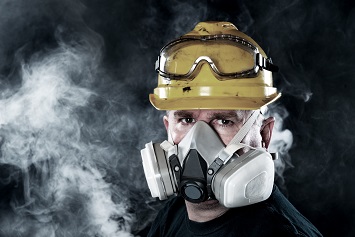The National Institute for Occupational Safety and Health (NIOSH) recently issued an FAQ on seal checking respirators. Seal checking a respirator is required by 29 CFR 1910.134(g)(1)(iii), which states: “For all tight-fitting respirators, the employer shall ensure that employees perform a user seal check each time they put on the respirator using the procedures in Appendix B-1 or procedures recommended by the respirator manufacturer that the employer demonstrates are as effective as those in Appendix B-1 of this section.”
Fit Testing
OSHA’s respiratory protection regulations at 29 CFR 1910.134 require that employees be fit-tested before the initial use of a respirator and whenever a different respirator face piece (size, style, model, or make) is used. There are two types of fit tests:
- Qualitative fit testing is a pass/fail test method that uses sense of taste or smell or reaction to an irritant to detect leakage into the respirator face piece. Qualitative fit testing does not measure the actual amount of leakage. Whether the respirator passes or fails the test is based simply on detecting leakage of the test substance into the face piece. There are four qualitative fit-test methods accepted by OSHA:
- Isoamyl acetate, which smells like bananas;
- Saccharin, which leaves a sweet taste in the mouth;
- Bitrex, which leaves a bitter taste in the mouth; and
- Irritant smoke, which can cause coughing.
- Quantitative fit testing is normally used for half-mask respirators—those that cover just the mouth and nose. Half-mask respirators can be filtering face piece respirators—often called N95s—as well as elastomeric respirators. Quantitative fit testing uses a machine to measure the actual amount of leakage into the face piece and does not rely on sense of taste, smell, or irritation to detect leakage. The respirators used during this type of fit testing will have a probe attached to the face piece that will be connected to the machine by a hose. There are three quantitative fit-test methods accepted by OSHA—generated aerosol, ambient aerosol, and controlled negative pressure. Quantitative fit testing can be used for any type of tight-fitting respirator.
All respirators must be NIOSH-approved, and medical evaluation and training must be provided before use.
Seal Checking
A user seal check is a procedure conducted by the respirator wearer to determine if the respirator is being properly worn. The user seal check can be either a positive pressure or a negative pressure check.
- During a positive pressure user seal check, the respirator user exhales gently while blocking the paths for air to exit the face piece. A successful check is when the face piece is slightly pressurized before increased pressure causes outward leakage.
- During a negative pressure user seal check, the respirator user inhales sharply while blocking the paths for air to enter the face piece. A successful check is when the face piece collapses slightly under the negative pressure that is created with this procedure.
A user seal check is sometimes referred to as a fit check. It should be completed each time the respirator is donned and is only applicable when a respirator has already been successfully fit tested on the individual.
NIOSH’s FAQ contains specific steps on performing positive pressure and negative pressure user seal checks.
Not an Alternative
Seal checks are not a regulatory substitute or alternative to fit tests.
“User seal checks do not have the sensitivity and specificity to replace either fit test methods, qualitative or quantitative, that are accepted by OSHA,” says OSHA. “A user should only wear respirator models with which they have achieved a successful fit test within the last year. NIOSH data suggests that the added care from performing a user seal check leads to higher quality donnings (e.g., reduces the chances of a donning with a poor fit).”


